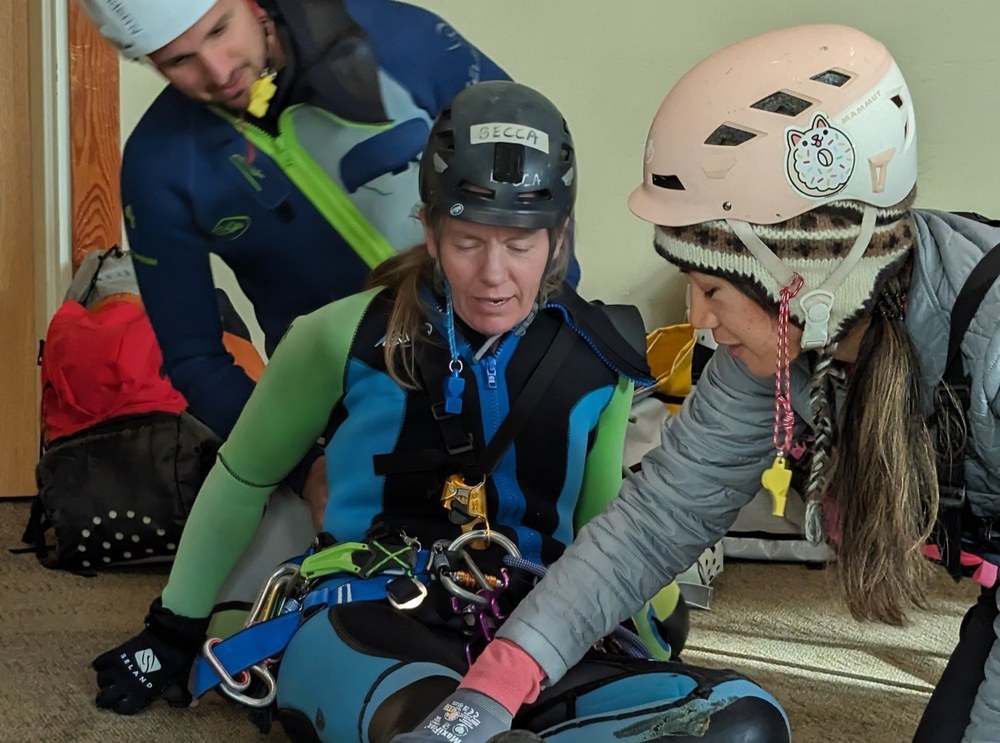
Wilderness First Aid (WFA) is important training for teams to have when they’re out adventuring, doing the types of things Mountaineers do. In town, a deep cut with a kitchen knife lands you in the emergency room. But when you’re surrounded by technical terrain, the first thing you have to do is get out. It will be many hours before you can get to the emergency room, so understanding how to stabilize an injury or a sick person until you can help them get out is critical. That’s where Wilderness First Aid training comes in.
Nationally, there are a number of companies that offer Wilderness First Aid training, all of which follow the Wilderness Medicine Education Collaborative (WMEC) Scope of Practice. Some of these are Remote Medical Training, NOLS, Wilderness Medicine Associates, SOLO, and Base Medical. The fact that they all follow the WMEC Scope of Practice makes for a high level of consistency between the courses, even 3,000 miles apart. The benefit is that everyone has the same foundational training and can work together as teammates and thought partners when an incident happens.
In the PNW, there is such a high demand for Wilderness First Aid training that WFA providers struggle to offer enough courses. Most courses try to expand capacity as much as possible, and large courses mean a wide variety of student needs. Some students are climbers, some are skiers, others paddlers. And while the foundational concepts remain consistent regardless of what environment you’re in, it becomes hard to make the content feel relevant to everyone, because it isn’t framed in their context.
This fall, the Canyoning Committee wanted to experiment with a homogenous course - a course with only canyoners. We decided to partner with Base Medical because their model - eight hours of online learning followed by eight hours in-person - lent itself to a customized day. What we liked about this model was that all students arrive with foundational knowledge from the eLearning materials. This ensures that, no matter the activity, students learn all of the required content in the scope of practice. Then, the in-person day can frame that content in a way that’s relevant to the audience through scenarios.
A day of canyoning-specific Wilderness First Aid
We started the in-person day with a review of the online content. Travis, our instructor, needed to check for comprehension. Before the course, Travis had spent a lot of time learning about canyoning and trying to understand what some real life scenarios would be in a canyon.
We showed up with all of our canyon gear, including wetsuits. This allowed us to practice WFA skills using the gear we’d have, rather than the standard sleeping bags and sleeping pads that are typically part of a WFA course. In every WFA course, students learn to do a “blood sweep” (checking for any bleeding that isn’t immediately obvious) as part of the initial patient assessment. Doing a blood sweep on someone who’s wearing a wetsuit isn’t possible without taking it off, and taking a wetsuit off accelerates hypothermia. It’s these types of considerations that we had an opportunity to reflect on and practice, because all of us were coming from the same context. In a standard WFA course with a mixed audience, there wouldn’t have been time to rabbit hole into those types of considerations that aren’t relevant in most other contexts.
Some of us also brought old wetsuits that we didn’t mind cutting. This turned out to be really valuable. In a canyon, no one wants to cut someone else’s wetsuit, and whoever is helping the injured person might not even think to cut off the wetsuit in an emergency. The simple action of practicing cutting a wetsuit developed a muscle memory in our brain so that if an injury does happen, we’ll think to cut someone’s wetsuit off if needed.
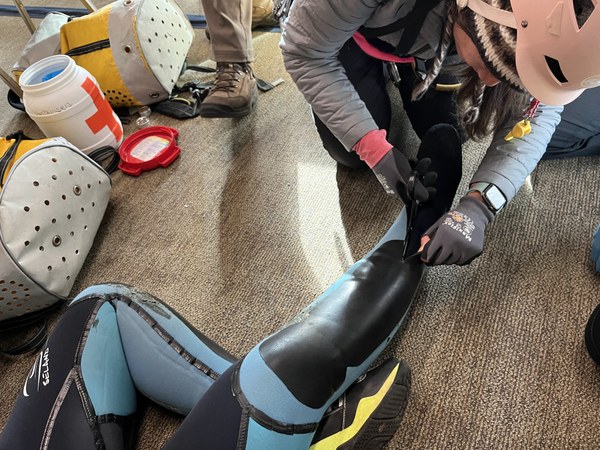
We spent the day putting skills to use in scenarios that were true to a canyoning environment: rockfall, drowning, foot entrapments, falling, and of course, illnesses. By the end of the day, we had practiced how to stabilize a variety of patients knowing that escape or rescue could be 5-24 hours away. We reflected on our first aid kits and what we might add or remove, as well as our order of operations in the event of an incident.
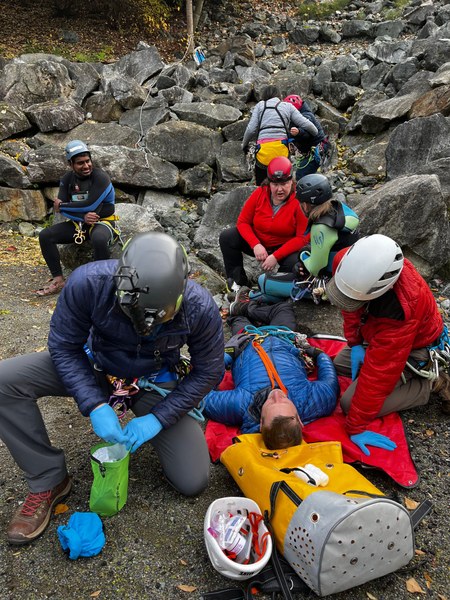
key Takeaways from our specialized Wilderness First Aid Course
I asked some of my peers what their key take-aways were, and here is what they shared:
- Hypothermia is a very big deal. We all know that. As canyoners, we’re managing for hypothermia all the time. What we hadn’t realized is how quickly blood loss can accelerate hypothermia, and how quickly an injured patient could become hypothermic. Our teams always bring one emergency blanket and one candle for each participant (a caving trick - try it! You’ll be amazed how much heat an emergency blanket can reflect off a little candle). We’re always focused on keeping the whole team warm when someone is injured. A key take-away for us was this: whoever is going into the first aid kit should get the emergency blanket out right after the gloves. No matter the injury - first gloves, then emergency blanket. Don’t wait for the injured teammate to start to seem cold. Keeping an injured teammate warm (rather than re-warming them) is especially important since hypowraps are very difficult in a canyon.
- Stop the bleeding. Also related to hypothermia, of course. Blood loss accelerates hypothermia, and it can be more challenging to stop a major bleed in a wet environment. We need to get the injured person out of the canyon, and sometimes that means moving them through technical terrain to get to a spot where a SAR team can access from the rim. And we need to keep them warm. We can’t move them over technical terrain if we can’t control the bleeding, and we cant put a wetsuit on them to keep them warm until we’ve stopped the bleeding and at least somewhat waterproofed the area.
- Gloves - what we liked was Travis’s comment: 'you don’t know your friends as well as you think you do.' We are a tight-knit community, and it was a good reminder to wear gloves, without exception.
- Practice with the gear you’ll use. We used our standard group first aid kits, and we wore wetsuits, harnesses, and helmets. The simple muscle memory of opening a dry keg, followed by a dry bag, followed by another dry bag, to access the first aid kit, and then opening individually packaged gauze is more helpful than we realized. It’s tough because it’s wasteful. But it’s hard to operate a kit that doesn’t spread out easily, and with adrenaline, it can feel even more challenging. Practice cutting wetsuits to access injuries.
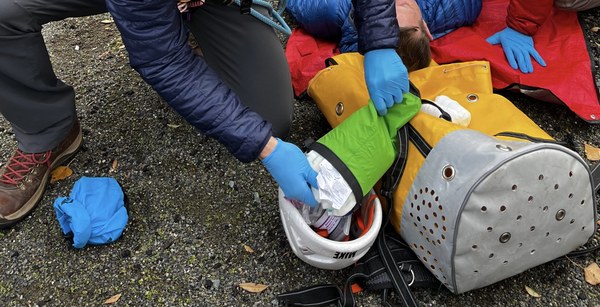
- We, as a canyoning community, need to do some more experimentation with hypowrap options with the gear we have. We may need to bring a heavier duty tarp, or perhaps more candles. This is something we hope to work out a standard for this spring.
Here are some things some folks said they’ll be adding to their first aid kits:
- 3ML dropper bottles for tincture of benzoin
- Israeli bandages
- Tourniquets
- More supplies for hypowraps
At the end of the day, everyone was very happy with the course. We spent the entire day envisioning and practicing how we’d apply wilderness medicine concepts in our unique canyon terrain.
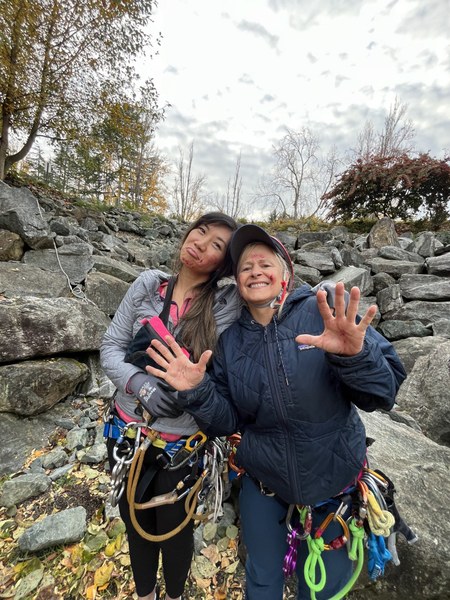
I highly recommend other activities give this model a shot. As my friend Dave said, “As leaders or assistant leaders, and as canyon team members, we are all agreeing to help each other in the canyon. There is a responsibility we have to each other and ourselves to practice, train, and learn. Everyone going on a canyon trip should be prepared to provide assistance.”
Add a comment
Log in to add comments.Great ideas for an activity specific WFA class! Thanks for the review, Becca!
 Becca Polglase
Becca Polglase